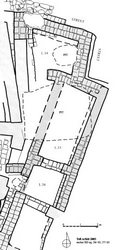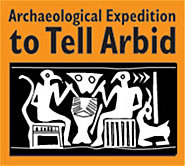SECTOR SD
Sector SD is located in the eastern part of the site, on a small plateau close to the limit of the main tell. Excavations of a large part of the area revealed meager remains of Middle Bronze Age structures as well as extensive and up to several meters thick deposits from the 3rd millennium BC.
Khabur Ware, Akkadian and Post-Akkadian Periods
The youngest remains are represented by Khabur ware period graves. Household structures of this date have not been found. A sequence of Post-Akkadian and Akkadian layers consisted mainly of poorly preserved, modest houses or courtyards. Still, the Akkadian level yielded a good collection of pottery and a few graves of adults and children.
A rich grave of a child, equipped with a set of pottery vessels, some jewellery and a bird-shaped rattle, probably belongs to the Post-Akkadian period.
Early Dynastic III and Ninevite 5 Periods
The most significant remains date to the Late Excised Ninevite 5 and ED III periods. From the end of the latter period comes a large and well-made house with courtyards. It was still in use at the beginning of the Akkadian Period. Two complete storage jars were found on the floor of one of its rooms. In other rooms and courtyards, a good collection of Akkadian pottery was found in situ. The house was equipped with a fine canalization drain for evacuation of water from the courtyards.
A building, presumably of great importance - a small shrine, judging by the plan - was found in a layer beneath the household. It had two phases. In the younger phase, it has a bent axis, similar to later Tell Brak temples, and is accessible through a vestibule from a street north of it.
Its very special feature, distinguishing it from other buildings in the vicinity, is its entrance with a threshold constructed of large stone blocks and stones. Unfortunately, the main part of the building is heavily damaged by a later pit.
A household structure, with a courtyard surrounded by rooms, abutted the shrine from the west. One of its rooms could have served for storage purposes and was perhaps a granary, accessible only from the top.
Beneath the ED III shrine, there was an earlier building, dating from the Late Ninevite 5 period. Its plan differed from that of the subsequent phase, but the spatial organization was similar here. In this initial phase, a sort of mud brick, multi-step platform was located in the central part of the building. Near the platform, there was a small compartment with a large pot and two smaller vessels sunk into the floor. This structure was built inside a large room, or courtyard, and was not surrounded by other rooms, as was the case in the subsequent phase. On the western side of the building, a long and narrow corridor, with a drain-like depression in the middle, ran in the direction of a carefully plastered room or enclosure. To the east of it, a complete dwelling house was excavated, with rooms located on different levels and an entrance from the eastern street. This house, with walls and floors covered with white plaster, also had a canalization system. The main room was equipped with benches along three walls and a well-like, round pit lined with bricks.
In the northern part of sector SD, at a relatively low level of the tell, a deep sounding was made to check the foundation level of the Ninevite 5 period settlement. However, the virgin soil has not been reached and the sequence of Ninevite 5 period layers continues all the way down, although the sounding has already reached a deeper level than that where the virgin soil had been reached in neighboring areas.
 back to research page
back to research page top
top

















